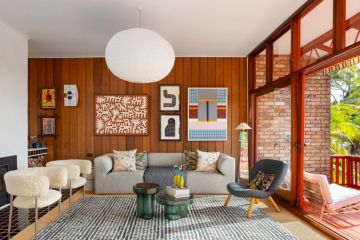Why Scandinavian design never goes out of style

With its high level of craftsmanship, well-considered design and honest natural materials, it is no surprise Scandinavian design remains an enduring style.
“Scandinavian design is not about fashion or style, but a way of thinking and life,” says leading interior designer Anna-Carin McNamara.
“They don’t see design as an add-on at the end, but always the starting point. As a movement, it has been a valuable resource, exported and appreciated globally since its conception in the early 1900s.”

Scandinavian design has become more mainstream in recent years, popular for its clean styling, pared-back lines, minimal aesthetic and functionality. Yet as a design movement, its reality is far more complex.
“It is who they are that makes Scandinavian design authentic, which is vastly different to simply ‘pared-back’,” says Anton Assaad, founder and director of Great Dane, a leading Scandinavian furniture store. “It is organic, soft, tactile, incredibly well made and engineered in a holistic way. Each item functions impeccably, be it the perfect coffee cup or reading light. Their designs are inherently beautiful and practical, but that doesn’t mean boring.”
At the core of the Scandinavian design movement is nature. The region’s environment, climate, changing seasons, forests and waterways heavily influence their design, colour palette and choice of natural materials, like leather, natural fabrics, timber and marble.

“Due to the harsh climate and long winters, Scandinavians have had to be very practical and stubborn to survive,” says McNamara. “It is innate in their psyche not to do anything halfway or give up before it’s done properly. These traits are reflected in the way they design their furniture and interiors.”
Assaad agrees. “It’s their appreciation of interiors and winter weather and being inside for six months of the year that influences them. The weather drives them indoors, so they need to create an environment that makes them feel happy in their home. For them, it is about the way they live, their environment and the seasons.”
Sustainability is also a hallmark of the movement. “Sustainability in the meaning it is built to last,” says McNamara. “When PP Mobler produces the round chair, the lifetime of that chair should be at least 100 years, which is the time it takes for a tree to grow to the size required to make another.”

While the term “luxury” is bandied around excessively, Assaad says it is the sheer authenticity of Scandinavian design that truly epitomises it.
“Luxury is authenticity, well-resolved design, and something beautiful to connect with and truly appreciate,” he says. It’s an aesthetic that is reflected in Great Dane’s new Paddington showroom. Featuring a white cloud-like interior with lots of timber, exposed brick and rich, green carpet, it is the perfect setting for showcasing the company’s rich collection of the region’s most prominent designers, including Hans Wegner, Nanna Ditzel, Borge Mogensen and J. L. Moller.
“We curate and create,” says Assaad. “It is a complete and very considered collection that includes lighting, furniture, accessories, textiles and rugs. We find designers who still reflect the authenticity of the movement and who design not just for today, but forever. And that to me, is why Scandinavian design endures.”

Four tips for mastering Scandinavian style
1. Go monochrome with a touch of pastel
Scandinavian design consistently uses a black and white colour scheme that imparts both a feeling of drama and calm. It is combined with soft and gentle washes like pistachio, soft bronze, gentle mint, and deep, gentle forest green. “Think crisp white bed linen styled with black throw cushions, striped rug or traditional Moroccan Berber, and artwork framed minimally in black and white frames,” says Lauren Lewis creative director at Bowerbird Interiors. “For impact, add a splash of pastel and apply in varying textures like marble, light woods and greenery for interest.”
2. Natural accents
“Add a sense of warmth and cosiness using natural materials like linen, cotton, wool, and sheepskin,” says Lewis. “Place pieces of furniture, like a chair or leather footstool, in an unexpected place to create a cosy nook in which to read and relax, and layer thoughtfully with beautifully textured blankets or throws.”
3. Lighting
“Choose well-considered lighting like candles, low-hung pendants, floor lamps and table lamps, as opposed to down lights,” says McNamara. “Always consider the human experience and how interaction will take place.”
4. Stylish storage
When it comes to Scandi style, less is more. “Declutter with conviction and store your belongings in discreet sleek storage,” says Lewis. “Every item should have a place to call home so stock up on wire and wicker baskets and trays for precious pieces.”
We recommend
We thought you might like
States
Capital Cities
Capital Cities - Rentals
Popular Areas
Allhomes
More







